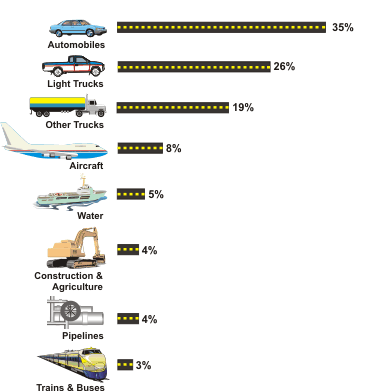The Not So Good News: Solutions for the Transportation and Heating sectors are potentially much more difficult than those for the electricity sector. The most important things we can focus on are conservation and efficiency.
The Better News: There are a lot of different ways to reduce our use of transportation and heating fuels. As you can see in the "Where Our Energy Comes From" section, the majority of heating is from industrial sources. This means that all we have to do is consume less and more responsibly, and we don't have to freeze in the dark in our homes. As you can see in the picture below from the U.S. Energy Information Administration, the distribution for transportation provides many opportunities for reductions. By being creative and responsible citizens and building up our mass transit and shipping systems, we can transition away from much of our reliance on cars and trucks.

- tips for conserving heating fuels
In December 2007, Congress passed an Energy Bill that increases the CAFE (fuel efficiency standard for vehicles) to 35 mpg by 2020, which is too little, too late. Read The Case for 40 mpg NOW to see how we can do more without the long wait.
While there are many proposals for alternative liquid fuels, all of them have major shortcomings, and none of them are scaleable to the level we would need to sustainably displace fossil fuel consumption. See links below for specifics:
Rather than alternative fuels, we advocate for electric vehicles (EVs) and plug-in hybrid electric vehicles (PHEVs). See links for more info:

